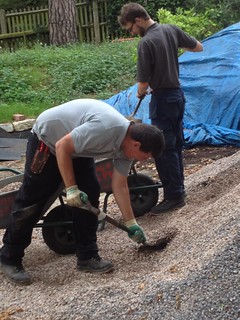Do we have to lift a weight? Can we use some manual handling aid? And, if it is repetitive lifting, can we mechanise the process?
Those were some of the main questions raised by the trainer, as he explained that the best he could do for us was to make us aware of the risks of lifting and the best ways to minimise them, the most part had to be done by us in changing our ways and, together with our employers, the workplace processes whenever we found that they were not suitable.
My main takeway was that nobody gains anything by doing more effort than is needed: work-related illnesses cost in the millions of lost days every year to the UK economy (there is quite a lot of information about this on the HSE website), and to the individuals their health, of course.
I was aware of the standard rules for lifting: bend your knees, keep your back straight. But I had not quite realised - being quite stockily built myself, and enjoying hard physical work - that there are marked differences in bone structure that make it safer for men to lift heavier weights than women and that it is silly to ignore, for example. In fact, health risks for women increase, more than the UK Health and Safety laws consider advisable, from lifting anything above 15kg. Also, I had not quite realised than the position of the weight makes lifting more or less risky: for example weights picked from the ground or lifted above shoulder height pose a greater risk than those picked from waist height.
A practical exercise also made me consider the difference that using a correct tool makes in minimising the lifting effort. We were asked to shovel some soil. I offered to try, and found the tool was so short I had to bend quite low, almost to the ground, which was hard work. Then, we were made to try a long-handled shovel, customary elsewhere in Europe. The leverage of the long handle made it light work indeed! The legend goes that English short-handled shovels originate from when miners were living the mines (where they were digging while kneeling) and carried their tools with them to other professions.
It may not be the whole story, but it certainly highlights the power of tradition in the practices we use, and the difficulty in introducing new ways of doing things where practices are established.
I will be certainly more careful now in considering my personal capacity to carry out a task and the possible consequences of excessive lifting, planning ahead to minimize the stress on my back (twisting it when handling weight is particularly damaging): hernias felt like a rather real risk after we got graphical explanation of bones and muscles in good detail.
Here's what HSE suggest about manual handling:
And I will be remembering to drink more to avoid reduced muscle performance from dehydration.
- Remove obstructions from the route.
- For a long lift, plan to rest the load midway on a table or bench to change grip.
- Keep the load close to the waist. The load should be kept close to the body for as long as possible while lifting.
- Keep the heaviest side of the load next to the body.
- Adopt a stable position and make sure your feet are apart, with one leg slightly forward to maintain balance

No comments:
Post a Comment